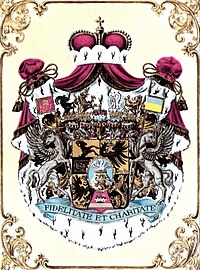

The House of Batthyány (Hungarian: [ˈbɒccaːɲi]) is an ancient and distinguished Hungarian noble magnate family. The Head of the family bears the title Prince (Fürst) of Batthyány-Strattmann, while other members of this family bear the title Count/Countess (Graf/Gräfin) Batthyány von Német-Ujvar respectively. A branch of the family (Croatian: Baćan) was notable in Bosnia and Croatia as well, producing several Bans (viceroys) of Jajce in the 15th and 16th century and later Bans of Croatia in the 16th, 17th and 18th century.
History
The Batthyány family can trace its roots to the founding of Hungary in 896 CE by Árpád. The family derives from a chieftain called Örs. Árpád had seven chieftains, one by the name of Örs, which later became Kővágó-Örs. In 1398, Miklós Kővágó-Örs married Katalin Battyány. King Zsigmond (Sigismund) gave Miklós the region around the town of Battyán (now called Szabadbattyán) and he took the name Batthyány (lit. "from Battyán"). The family were first mentioned in documents in 1398 and have had their ancestral seat in Güssing in the Austrian region of Burgenland since 1522.
In 1570, Boldizsár Batthyány transformed the seat of the family, Güssing, into the center of Protestantism in the region. His descendant Ádám Batthyány (1610–1659), however, was Catholic and founded a Franciscan monastery in Güssing. On 3.1.1764 Count Karl Josef Batthyány was created Prince of the Holy Roman Empire. As he didn't have surviving sons, his princely title was inherited by his nephew Count Adam Wenzel (1722–1787). Count Lajos Batthyány became the first Prime Minister of Hungary during the Hungarian Revolution of 1848 and was executed in Pest in 1849. After 1945, the Batthyány family's property was largely expropriated in Hungary and other countries under Communist rule, although they retained their property in Austria.
Modern era
Currently, the family has about 60 name bearers who live mainly in Austria, but also in Hungary, Germany, United States and Uruguay. The current head of the family is Prince Laszlo Edmund Christof Maximilian Eugen Anton von Batthyány-Strattmann, son of Prince Laszlo Pascal von Batthyány-Strattmann (1938–2015) and his wife Veronika Hauschka von Treuenfels (born 1942). Prince Laszlo lives with his wife and children in Austria.
Notable members
- Boldizsár Batthyány (1543–1590), baron, well-educated humanist, became Protestant in 1570, protector of the botanist Carolus Clusius

- Ádám Batthyány (1610–1659), count, Founder of the Franciscan monastery in Güssing
- Adam II. Batthyány (1662–1703), Ban of Croatia
- Lajos Batthyány (1696–1765), Hungarian Court Chancellor and Palatine of Hungary.
- Károly József Batthyány (1698–1772), Austrian field marshal and later educator of Joseph II, Ban (viceroy) of Croatia
- József Batthyány (1727–1799), bishop
- Ignác Batthyány (1741–1798), bishop and founder of the Batthyaneum Library, Alba Iulia, now Romania
- Kázmér Batthyány (1807–1854), politician, minister in the Hungarian Revolution of 1848
- Franciska Batthyány (1802–1861), born Széchenyi
- Lajos Batthyány (1807–1849), executed, first Hungarian Prime Minister
- Count József Sándor Batthyány (1777–1812), his father
- Gusztáv, 5th Prince Batthyány-Strattmann (1803–1883), English sportsman, Thoroughbred racehorse owner/breeder
- Edmund Gustavus, 6th Prince Batthyany-Strattmann (1826–1914)
- Ludovika Olga Karoline Philippine Antonia Batthyany (1869–1939)
- Count Tivadar Batthyány (1859–1931)
- László, 7th Prince Batthyány-Strattmann (1870–1931), ophthalmologist, beatified in 2003
- Ervin Batthyány (1877–1945), anarchist and school reformer
- Countess Margit Batthyány (1911–1989) (de), lived until the end of World War II in Castle Rechnitz (Burgenland) where she was engaged in breeding horses and maintaining a reconvalescence home for members of the SS. Her involvement in the infamous Rechnitz massacre is still controversial.
- Sacha Battyhány, Swiss journalist and writer, author of the book "A Crime in the Family" about the participation of Comtesse Margit Battyhány and other members of the family in the Rechnitz massacre
See also
References
- August Ernst, Geschichte des Burgenlandes, Oldenbourg Wissenschaftsverlag, 1991, p.140
- András Koltai, Adam Batthyány und seine Bibliothek, Országos Széchényi Könyvtár, 2002, p.292
- Miklós Füzes, Batthyány Kázmér, Gondolat, 1990, p. 5
- Mántaras, Patricia (2021-09-07). "Carlos Batthyány: "Cuando salgo a correr la cabeza se apaga y me da mucha tranquilidad"". Galería. Archived from the original on 2021-12-19. Retrieved 2024-08-03.
- "Stefan Klemp: Good comrades (29/10/2007) - signandsight".
- "My Aunt Had a Dinner Party, and then She Took Her Guests to Kill 180 Jews". Haaretz.
External links
- Family website
- Archival material (ca. 212 running meters): The Batthyány Family Archive at the National Archives of Hungary
- Archival material (about 200 records): Batthyány Family Collection at the National Library of Israel (ARC. 4* 2031)
- Shaul Greenstein, The Hungarian Noble Family That Took in the Exiled Jews, The Librarians, Blog of the National Library of Israel, December 18, 2018